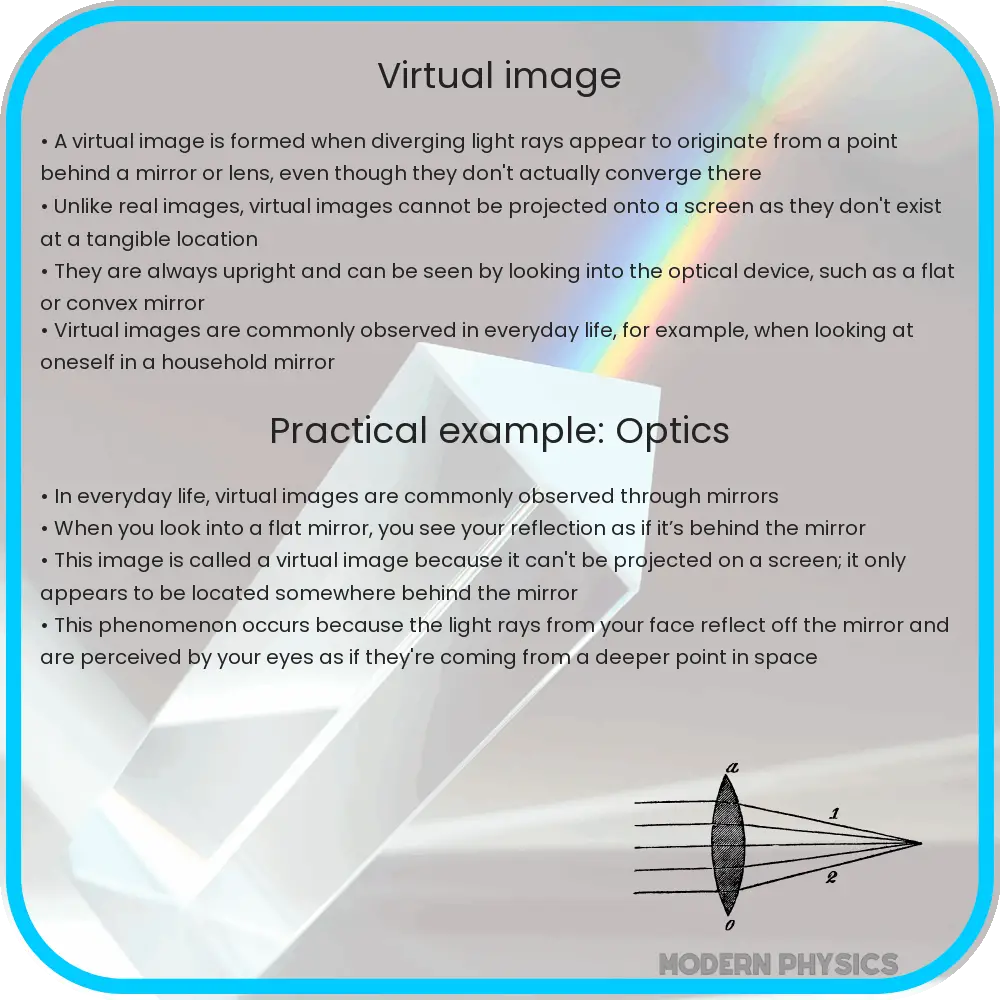Understanding virtual images in optics: their clarity, formation through lenses and mirrors, and key uses in magnifying glasses, microscopes, and telescopes.

Virtual Image | Clarity, Formation & Uses in Optics
In the world of optics, images are categorized into two types: real images and virtual images. While real images are formed by the actual convergence of light rays, virtual images arise from the apparent divergence of light rays. This article will delve into the concept of virtual images, explaining their clarity, how they are formed, and their practical uses in various optical devices.
Clarity of Virtual Images
Virtual images are characterized by certain distinctive features:
- They cannot be projected onto a screen as they do not involve actual convergence of light rays.
- They appear to be located somewhere behind the optical device, unlike real images which can appear in front.
- Typically, virtual images are upright as opposed to real images which are usually inverted.
Due to these characteristics, virtual images are often clearer and more stable than real images when viewed directly through an optical device like a lens or a mirror.
Formation of Virtual Images
A virtual image is formed when light rays diverge after reflecting off a surface or passing through a lens, making them appear to originate from a distinct location behind the lens or mirror. The following are key examples of how virtual images are formed:
- Concave Lenses: When parallel rays of light pass through a concave lens, they diverge. To an observer, it appears as if these rays are emanating from a focal point on the same side as the light source, creating a virtual image.
- Convex Mirrors: For convex mirrors, incident light rays diverge upon reflection. Observers see the rays as though they come from a point behind the mirror, forming a virtual image.
- Plane Mirrors: The most common example is the image formed by a plane mirror. Here, the distance between the object and the mirror equals the perceived distance of the virtual image on the other side of the mirror.

Figure 1: Formation of a virtual image by a plane mirror.
The nature of the lens or mirror determines whether light rays diverge or converge, thereby influencing the position and properties of the virtual image.
Uses of Virtual Images in Optics
Virtual images play a crucial role in various optical applications:
- Magnifying Glasses: By using convex lenses, magnifying glasses create larger virtual images of objects, making it easier to observe small details.
- Microscopes: In microscopy, virtual images are generated at each stage, allowing detailed observations of minute specimens.
- Telescopes: Telescopes use multiple lenses and mirrors to produce virtual images of distant celestial bodies, facilitating their study.
In these examples, the virtual image enhances the functionality of the optical device, providing viewers with a clearer and sometimes magnified view of the object in question.
Comparing Virtual Images to Real Images
While virtual images are immensely useful, it’s beneficial to understand how they stack up against real images:
- Formation: Real images are formed by actual light rays meeting at a point, whereas virtual images result from rays appearing to diverge from a point behind the optical device.
- Projection: Real images can be projected onto a screen since actual light intersects at a point. In contrast, virtual images cannot be projected because they do not involve actual light intersection.
- Orientation: Real images are generally inverted (upside down), while virtual images are typically upright.
These fundamental differences highlight why both types of images are unique and offer varied applications in the world of optics.
Common Misconceptions About Virtual Images
Even though virtual images are a staple in many optical devices, there are some common misconceptions worth addressing:
- Misconception: Virtual images are always blurry.
Fact: Virtual images can often be clearer and more stable than real images, given the right optical setup and conditions. - Misconception: Virtual images depend on the type of object.
Fact: The formation of virtual images is dependent on the type of lens or mirror used, not the nature of the object itself. - Misconception: Virtual images are less useful.
Fact: Virtual images are extensively used in devices like magnifying glasses, microscopes, and telescopes, making them incredibly valuable in various fields.
Conclusion
Understanding virtual images opens up a fascinating aspect of optics that is crucial to numerous applications. From the fundamental principles that distinguish them from real images to their instrumental role in magnification and observation, virtual images are fundamental to modern optical technology. Their clarity, stability, and unique formation properties make them indispensable in both everyday tools like mirrors and advanced scientific instruments like microscopes and telescopes.
As you explore more about optics, recognizing and appreciating the role of virtual images helps in gaining a deeper understanding of how we perceive and interact with the world around us through various optical devices.
